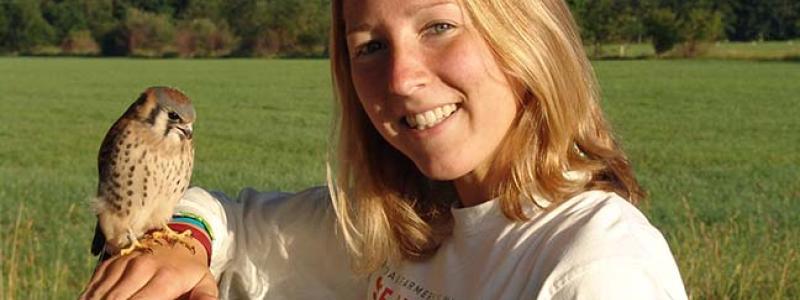For almost a decade, Karen Steensma, M.Sc., an associate professor of biology and environmental studies at TWU, has been studying birds—both beneficial birds and those causing devastation to livestock and crops. As a dairy farmer from Washington State, Steensma noticed that European starlings were getting into her dairy cows’ feed, then flying over to her neighbour’s blueberry farm to gorge on “dessert.”
“The birds not only pick out the choicest, most nutritious parts of dairy feed,” she says, “but bird fecal matter in barns may spread disease.” Steensma and collaborators have estimated that across North America, about $800 million in damage is done to fruit by birds each year.
The offending birds include starlings, crows, and American robins, among others. Yet insect-eating swallows and rodent-eating birds of prey, including falcons and barn owls, can be considered highly beneficial to farmers.
To test their deterrent effect on pest birds, Steensma installed American kestrel falcon nest boxes. Few kestrels live west of the Cascade Mountains, but Steensma and her team successfully brought young kestrels from the east. Kestrel effectiveness data are still being collected.
The team also observed effects of air dancers, distress call boxes, loud cannons, netting, sprays, and kites designed to look like falcons to scare away the nuisance birds. Although most scare methods had some initial success, after a while the birds would catch on—seeing these tactics as false threats.
Positive results occurred with falconry-based bird abatement. This method has a professional falconer spend the entire season on the farmer’s property to fly birds of prey. The falcons are trained to haze the nuisance birds, keeping crops safe with low environmental impact. “This allowed farmers to avoid noisy cannons, pesticides and other undesirable techniques,” Steensma says. The downside of falconry was the cost—up to $20,000 to protect 50 acres for one season.
“This is a huge issue for both Canada and the United States,” says Steensma. “Birds aren’t bound by borders as we are.”
The latest development in Steensma’s ongoing study is her collaboration on two grants that just received funding from partners south of the border at Washington State University (WSU).
The first, from the US Department of Agriculture-Western Sustainable Agricultural Research and Education is a $240,000 grant for a three-year study of the effects of birds on dairy cow welfare and dairy profits. The second, an $80,000 grant from WSU Emerging Concepts, is preliminary research on the idea of a drone-falcon to chase pest birds out of agricultural settings.
To date, Steensma’s nine years’ of research have generated over $2.4 million in direct funding for TWU and collaborating institutions, and $2 million in-kind from growers and cooperators. The team includes researchers from Michigan State University, Cornell University, Oregon State University, and Western Washington University, as well as WSU. The ongoing bird study has also provided material for 10 undergraduate theses (at TWU, Seattle Pacific University, and Whitman College), one MS thesis (Deanna Leigh, TWU ’07; Western Washington University ’15), and launched five students into various graduate schools.
Based on the work her team has done so far, Steensma sees a combination of both technology and natural systems as potentially effective in keeping nuisance birds away. “As much as using the natural falcons appeals to me, technology could also be a low impact way to achieve the same results,” she says. “Both could be useful, and both are part of our exploration of creation. We have to use the abilities that God has given us as scientists to think of new, sustainable ways to produce food.”

